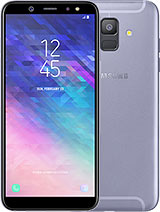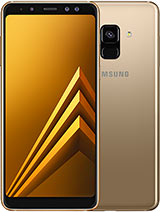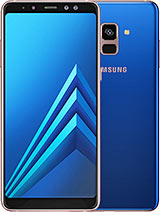Introduction
Isn't the Samsung A-series just a royal mess - even numbers, odd numbers, pluses sprinkled here and there, and a year stamp to top it all off. Let's go ahead and see what the Galaxy A7 (2018) is exactly and who it's for.

In the absence of an A5 this year, the A7 (2018) and the A9 (2018) happen to be the two odd-numbered phones, and they have something in common - each has a few cameras more than usual. The A9 goes all out with 4-module array on its back - a normal wide angle, an ultra wide angle, a telephoto, and one more just for depth detection. Well, the A7 skips the telephoto, but that's still three cams on a midranger. Just on the back, that is - there's an extra one above the display for selfies, and it's paired with a flash too.
Then there are a couple of very Samsung things you'll find on the A7 - a SuperAMOLED display and an Exynos chipset. The 6-incher has a FullHD resolution in a tall aspect, the SoC is made on a 14nm process, so all is perfectly fitting the handset's market segment - it's well specced, but not too well specced.
Samsung Galaxy A7 (2018) specs
- Body: Glass back, plastic frame; 159.8x76.8x7.5 mm, 168g; Gold, Blue, Black color schemes;
- Display: 6.0" Super AMOLED, FullHD+ 2,220x1,080px resolution Infinity display (18.5:9 aspect ratio), 411ppi pixel density.
- Rear camera: Primary 24MP, f/1.7 aperture; phase detection autofocus. Secondary 8MP, f/2.4 aperture, fixed focus, 13mm ultra wide angle. Third 5MP, f/2.2 aperture, depth sensing only. LED flash. 1080p/30fps video recording.
- Front camera: 24MP, f/2.0 aperture; fixed focus; 1080p/30fps video recording.
- OS/Software: Android 8.0 Oreo; Samsung Experience 9.0 custom overlay.
- Chipset: Exynos 7885: octa-core CPU (2x2.2GHz Cortex-A73 + 6x1.6GHz Cortex-A53), Mali-G71 GPU.
- Memory: 4GB of RAM, 64 of storage or 6GB of RAM, 64/128GB of storage (market dependent); dedicated microSD slot for expansion.
- Battery: 3,300 mAh Li-Po (sealed).
- Connectivity: Single/dual SIM; LTE Cat. 6 (300Mbps download/50Mbps upload); microUSB 2.0 port; Wi-Fi a/b/g/n/ac; GPS, GLONASS, BDS; NFC (market dependent); Bluetooth 5.0; FM radio.
- Misc: Rear-mounted fingerprint reader; Samsung Pay; single speaker on the bottom; 3.5mm jack.
For example, there's no form of fast charging, and the bundled adapter is quite the weakling. At least there's not all that much battery to fill up. Wait, what? No, really though, the otherwise modest 3,300mAh capacity should be more than adequate for the display/chip combo if previous experience is any indication. That said, there's nothing adequate about a microUSB port, not on any phone anymore, but certainly not on a mid-tier A-series model, even if that A isn't quite what it used to be.
Anyways, let's calm down and see what you'll walk out of the store with.
Samsung Galaxy A7 (2018) unboxing
A rather plain white cardboard box, that's what, with a simple shiny blue 'A7' being the only accent. It doesn't get much fancier than that on the inside, where you'll find an outdated 5V/1.55A adapter and a USB cable to go with it. On the plus side, there's a pair of earbuds - basic, but included.

There's no need for excess in the presentation, however - the phone has plenty of flair all on its own, particularly the blue one we have for review.











Samsung Galaxy A7 (2018) frequency response


Design and 360-degree spin
We mentioned the mess the Galaxy A-series is right now in terms of sheer number and variety of models and that reflects the build. Gone are the days when A meant a certain design and the number after it stood mostly for size.

So in a year when the A6 models use aluminum unibodies and the A8 varieties are glass front and back held together by an aluminum frame, the A7 is a similar glass sandwich but with plastic replacing the aluminum for the frame. It looks almost like the real thing, to an extent, but there's no escaping the fact that the handset feels almost too light for its size, in a slightly inexpensive kind of way.

The A7 (2018) measures 159.8x76.8x7.5mm and weighs in at just 168g, when the A6+ (2018) is 186g and the A8+ (2018) is even heavier at 191g - all three of them six inchers. That said, the Oppo F9 is actually in the A7's weight ballpark (169g), while the vivo V11 is even lighter at 156g. The smaller 5.84-inch Nokia 7.1 is 160g.
So, with the numbers out of the way, let's just say we're loving the blue color scheme on our review unit. Everyone seems to be doing blue phones one way or the other recently, Samsung included, but it's this particular intense tint that we want to see on flagships instead of the 'sort of blue' you'd find on a Galaxy Note9 (though, admittedly, we do have a thing for LG's Moroccan Blues, too).
So, with the numbers out of the way, let's just say we're loving the blue color scheme on our review unit. Everyone seems to be doing blue phones one way or the other recently, Samsung included, but it's this particular intense tint that we want to see on flagships instead of the 'sort of blue' you'd find on a Galaxy Note9 (though, admittedly, we do have a thing for LG's Moroccan Blues, too).

One thing we hate, and we always have, is the 'Duos' stamp on the back. Who in their right mind wants to show off that they have a dual SIM phone? Not that it's a bad thing using two SIMs, it's just not something you actively want to put in peoples' faces. The rationale behind a separate logo eludes us it's there to no practical or aesthetic benefit, and we hate it. Whew.
At least on this particular model there's something else to draw attention away from the text - yes, that would be the triple camera assembly. Housed behind a common window the modules go like this - top one is the 5MP depth sensor, middle one is the primary 24MP unit, and on the bottom is the 8MP ultra wide cam. The cameras' single LED flash sidekick is outside on its own.

On the front, there's the 6-inch Super AMOLED that is pleasantly notchless - Samsung is still leading the #resist movement. It's its fair share of bezels all around, so that 'Infinity display' line in promo materials is mostly marketing speak. Even so, at least things are symmetrical and chin and forehead are equal instead of the phone being top heavy - one Pixel 3 comes to mind.

The A7's top bezel is full of the stuff you'd expect to find there which is giving designers a hard time and has us looking at notches all day. We're talking earpiece (which, sadly, isn't a second speaker), ambient light and proximity sensors, camera, and even a flash. There's no notification LED, though, bummer.
What's gone unaccounted for so far is the fingerprint reader - is it possible there isn't one on the Galaxy A7 (2018)? No, it's just in an unusual spot. Samsung's pulled a Sony, and fitted a fingerprint sensor in the side-mounted power button.
The button is in the customary spot on the right side above the mid point, it's just recessed into the frame instead of sticking out. Its placement is ideal for use with the thumb of your right hand, but if you're a smartphone-leftie, unlocking with your index or middle finger is likely to be awkward. Meanwhile, you may accidentally brush it with any part of your hands and pull down the notification shade (though that gesture can be disabled in settings).

Which brings us to another questionable decision on Samsung's part. Okay, the power button is now also a fingerprint reader, but what does that have to do with the placement of the volume buttons? They've now been relocated to the right side too, high up towards the top. It's not really that big of a deal, but it'll require some getting used to if you're a long-time Samsung user.
The left side is home to one thing, and it's the card slot. It's our favorite type - it holds two nano SIMs and a microSD.
Down on the bottom, disappointment awaits. Okay, not really, because you already know from the unboxing that the Galaxy A7 (2018) (mind you, 2018) uses the microUSB standard for charging and wired connectivity. Still, we feel that the choice of the old connector is a bad one.
On a positive note, there's a headphone jack?

Going over the hardware, we can't help but notice that there's no IP rating for water and dust protection. Given the A7's plastic build and less premium market placement, it's not all that surprising. It's just that the A7 (2017) was weather-sealed and this one isn't, and it's another development that leaves a bad taste in our mouths, even if we understand that a lot has changed in the almost two years since that came out.

SuperAMOLEDs in the midrange aren't half bad
The Galaxy A7 (2018) comes with one of Samsung's SuperAMOLED displays - in 6-inch, FullHD+ spec with some rounded edges, but no curves. The 2220x1080 pixels in an 18.5:9 aspect ratio work out to a 411ppi pixel density.

We measured a maximum brightness of 602nits in Auto mode and 402nits when you put the ambient light sensor to rest. The value in manual mode is actually higher than what we got out of the Galaxy S9s and the Note9 by a few dozen nits, though the flagships do brighten up a little more in Auto. In any case, the A7 (2018) has brightness to spare. Black is truly black, as usual, resulting in infinite contrast, while the minimum brightness of 2nits means the A7 will be easy on your eyes in absolute darkness.
| Display test | 100% brightness | ||
| Black, cd/m2 | White, cd/m2 | ||
| 0 | 402 | ∞ | |
| 0 | 602 | ∞ | |
| 0 | 425 | ∞ | |
| 0 | 533 | ∞ | |
| 0 | 390 | ∞ | |
| 0 | 590 | ∞ | |
| 0 | 387 | ∞ | |
| 0 | 568 | ∞ | |
| 0 | 418 | ∞ | |
| 0.29 | 526 | 1814 | |
| 0 | 455 | ∞ | |
| 0.277 | 420 | 1516 | |
| 0.314 | 461 | 1468 | |
| 0.414 | 470 | 1135 | |
| 0.313 | 460 | 1470 | |
| 0.377 | 490 | 1300 | |
| 0.465 | 600 | 1290 | |
The Galaxy A7 (2018) aced our sunlight legibility test, posting a higher contrast number than the Note8, for example. Interestingly enough, the A7 (2018) is noticeably better in this respect than this year's A6+ and A8. As for immediate competitors, the vivo V11 is a tiny bit less contrasty in the sun, but the IPS panel of the Oppo F9 is no match for the SuperAMOLEDs.
Sunlight contrast ratio
As for colors, Samsung's approach is the same on the midrangers as it on the high-end devices. You have the default Adaptive mode, where colors are very punchy, but the color reproduction doesn't adhere to any particular color space (average DeltaE is 5.5 against an sRGB target). There there are the dedicated color modes that target specific color spaces, and do so quite accurately. AMOLED Cinema is the DCI-P3 mode (average DeltaE of 2.1), AMOLED Photo is for AdobeRGB content (average DeltaE of 2.0), while Basic is your sRGB mode - average DeltaE is 1.9.
Samsung Galaxy A7 (2018) battery life
The battery capacity of the Galaxy A7 (2018) is rated at 3,300mAh, some 300mAh more than the smaller 5.6-inch Galaxy A8 (2018) with the same chipset. Meanwhile, the A6+ (2018) and A8+ (2018), both 6-inchers, rely on 3,500mAh power packs. Competitors like the vivo V11 and Oppo F9 are in the same ballpark with their respective 3,400mAh and 3,500mAh cells, though both have larger displays. On the other hand, the smaller 5.84-inch Nokia 7.1 has 3,080mAh worth of juice.
The Galaxy A7 (2018) showed praiseworthy endurance in our testing, for an overall rating of 93 hours. It lasted 12 hours on our web browsing script, and 15 hours weren't enough to deplete the battery while looping videos (clearly got very close, though). With more than 25 hours on a 3G call and generally frugal 3G standby power consumption, the A7 (2018) proved it made good use of its battery.

Our endurance rating denotes how long a single battery charge will last you if you use the Samsung Galaxy A7 (2018) for an hour each of telephony, web browsing, and video playback daily. We've established this usage pattern so our battery results are comparable across devices in the most common day-to-day tasks. The battery testing procedure is described in detail in case you're interested in the nitty-gritties. You can also check out our complete battery test table, where you can see how all of the smartphones we've tested will compare under your own typical use.
Both the vivo and the Oppo outlast the Galaxy by about an hour and a half in web browsing, but neither is a match in video playback, while the Nokia trails in both disciplines. The F9 is the longest standing talker of the group, the Galaxy a couple of hours behind.
The phone's great endurance is marred by the slow charging process - the 2:22h for a full top up is just bearable, but the 25% charge you'd have at the 30-minute mark means you'd better not forget to plug it in overnight. It's hardly surprising given the low-output charger, but it's the very existence of said low-output charger that bothers us to begin with and we feel it has no place in an A-series box. Same with the microUSB port of the phone, just to reiterate.
Loudspeaker
The Galaxy A7 (2018) has a single loudspeaker, a down-firing one unlike the side-mounted speakers of other A-series phones. Three test tracks later, its numbers placed in the 'Very Good' category in our loudness test.
| Speakerphone test | Voice, dB | Ringing | Overall score | |
| 66.6 | 66.1 | 81.5 | Good | |
| 70.2 | 74.7 | 70.0 | Good | |
| 68.3 | 73.8 | 75.8 | Good | |
| 67.5 | 71.3 | 79.7 | Good | |
| 69.4 | 70.9 | 79.9 | Very Good | |
| 69.2 | 70.6 | 81.6 | Very Good | |
| 67.8 | 70.0 | 84.2 | Very Good | |
| 70.7 | 73.8 | 80.7 | Very Good | |
| 69.1 | 74.8 | 81.4 | Very Good | |
| 71.7 | 74.4 | 81.6 | Very Good | |
| 70.1 | 73.1 | 85.4 | Excellent | |
| 70.5 | 74.1 | 85.2 | Excellent | |
| 76.3 | 73.4 | 81.1 | Excellent | |
| 75.6 | 76.0 | 81.1 | Excellent | |
| 72.8 | 74.7 | 86.6 | Excellent | |
| 89.5 | 72.2 | 89.8 | Excellent |
Audio quality
The Samsung Galaxy A7 (2018)'s audio output with an external amplifier was flawlessly clear, while its loudness was well above average, making this a great start.
Headphones caused a moderate amount of stereo crosstalk and some intermodulation and harmonic distortion, but those last two aren't high enough to make a difference in real life. Volume dropped a bit, but still remained above average, so all in all a solid performance by the mid-ranger.
| Test | Frequency response | Noise level | Dynamic range | THD | IMD + Noise | Stereo crosstalk |
| +0.02, -0.02 | -93.1 | 92.9 | 0.0026 | 0.0089 | -92.5 | |
| +0.25, -0.17 | -91.4 | 91.6 | 0.115 | 0.306 | -55.4 | |
| +0.02, -0.06 | -91.0 | 88.6 | 0.0021 | 0.016 | -94.4 | |
| +0.05, -0.03 | -93.8 | 89.6 | 0.0019 | 0.034 | -54.9 | |
| +0.01, -0.02 | -94.7 | 94.7 | 0.0013 | 0.0086 | -73.1 | |
| +0.12, -0.09 | -93.8 | 93.8 | 0.0035 | 0.115 | -71.7 | |
| +0.01, -0.03 | -93.0 | 93.1 | 0.0037 | 0.0093 | -92.9 | |
| +0.12, -0.06 | -92.3 | 92.5 | 0.0027 | 0.088 | -65.7 | |
| +0.01, -0.02 | -93.6 | 93.6 | 0.0010 | 0.0069 | -93.8 | |
| +0.65, -0.08 | -91.2 | 92.5 | 0.0082 | 0.359 | -50.3 |

Samsung Galaxy A7 (2018) frequency response
Experience Oreo the Samsung way
The Galaxy A7 (2018) runs on Android 8.0 Oreo with Samsung Experience 9.0 on top, just like the rest of the recent A-series phones. The Note9 may be getting an extra 0.1 of Android and 0.5 of Experience, but it's hard to tell the difference - of course, accounting for the missing features.

AOD has been getting more and more ubiquitous on Samsung phones and is present on the A7 (2018) as well. You're treated to a host of different layouts and clock options, plus the choice to keep it on all the time or only according to a schedule.
The all-new fingerprint sensor is set up in much the same way as on other Samsungs (read a lot of taps), only this one is somewhat trickier due to the size and shape. Additionally, you can only register 3 prints, as opposed to the usual 5. Even so, the sensor is still always on, so you don't need to press on the button and a tap will work just fine for unlocking. It's not blazing fast, but it does work pretty much all the time.
It can also be set up to bring down the notification shade and quick toggles, and it works great when you're showcasing the feature to a friend. In actual use, however, we found ourselves accidentally swiping on it and pulling the notifications all the time. Whew, good thing you can have that off. A much more reliable solution is the 'swipe on an empty homescreen area to pull the notifications shade' feature - wait, it's called 'quick-open notification panel'.
Nothing has really changed on the lockscreen, homescreen, or the notification shade. The task switcher (now with optional list view) is the place where you can initiate multi-window or pop-up apps - Samsung's really unmatched in the versatility of its multi-tasking implementation.
Just like other Galaxies, the A7 (2018) supports themes, and there's a ton available in the store. Secure folder is also present on the A7, and it's where you can keep files, memos and apps away from prying eyes. Then there's Game launcher to keep your games in one place and in-play Game tools to disable notifications and the nav bar as well take screenshots or record gameplay.
Samsung is using its own Gallery app where the Pictures pane is a timeline of photos and screenshots, while Albums has them sorted by origin instead. Stories is Samsung's take on shareable collaborative albums, which we'd be surprised if anyone uses. There's a powerful editor on board for when you're away from a PC.
Google Play Music is the default player for you tunes, not Samsung's own Music. The sound settings are proprietary though, with either a simple two dial adjustment or a proper 9-band equalizer at your disposal. Especially useful is the Adapt Sound feature which tunes the EQ to your hearing and your particular pair of ears and headphones by playing multiple frequencies and asking how well you hear them. An FM radio receiver is also available.
Synthetic benchmarks
It's the Exynos 7885 that ticks inside the Galaxy A7 (2018), the latest and most powerful in Samsung's in-house line of mid-tier chipsets. It's also efficient thanks to the 14nm fabrication process, which we proved in the battery section.
The octa-core CPU is in a 2+6 configuration with 2x2.2GHz Cortex A73 and 6x1.6GHz Cortex A53 cores (side note - the Snapdragon 710 uses a similar arrangement, only it's got newer Cortexes - 2xA75+6xA55). The GPU on the A7 is Mali-G71. As for RAM, 4GB and 6GB options exist, though not all markets will necessarily get both and the 6GB version could be had with 64GB or 128GB of storage. Our review unit is in the basic 4GB/64GB trim.

You know the drill - some GeekBenching comes first which puts a numerical value on CPU performance. Here, the Galaxy A7 (2018) posts virtually the same scores as its A8 brother in both single and multi-core tests. The single-core figures are better than Oppo F9's (Helio P60) and the Nokia 7.1's (S636) or vivo V11's (S660). Other S660-powered phones like the Mi A2 and Samsung's own A9 (2018), however, score higher in the single-core test, and the Mi 8 SE with the S710 is clearly in a different league.
GeekBench 4.1 (single-core)
Higher is better
In the multi-core test the A7 (2018) loses to all the S660 phones - even the underperforming Mi A2 is an inch ahead, while the vivo V11 and the Oppo F9 are high up the chart. The Nokia 7.1 is roughly in the middle.
GeekBench 4.1 (multi-core)
Higher is better
In the graphics department, the Galaxy A7 (2018) scores okay-ish, though it is bested by pretty much the entire batch of competitors, with even the Snapdragon 636 handsets edging it in the onscreen test. The Snapdragon 660's GPU is clearly more powerful as the results of a handful of phones here will attest. Meanwhile, for the most performance short of a truly flagship GPU, the S710 is the way to go, represented here by the Mi 8 SE.
GFX 3.1 Manhattan (1080p offscreen)
Higher is better
GFX 3.1 Manhattan (onscreen)
Higher is better
Take CPU and graphics tests and mash them up with some storage and RAM torture and a few minutes later you'd have an Antutu result. The Galaxy A7 (2018) reclaims its victory over the S636 Nokia 7.1 and Redmi Note6 Pro, but the S660 rivals remain out of reach.
AnTuTu 7
Higher is better
All in all, the Galaxy A7 (2018)'s internals are clearly geared towards efficiency with performance being lower on the list of priorities. Even so, its CPU does really well in single-core tasks, and adequately under multi-core loads, while the GPU isn't as potent as those found on the competitors.






Samsung Galaxy A7 (2018) against the Oppo F9 and the vivo V11 in our Video compare tool


A trio of cameras
The Galaxy A7 (2018) comes equipped with three cameras - a primary one (which we may call normal, regular, wide or whatnot), an ultra wide angle one (note the 'ultra' bit), and an additional one to aid in depth detection for portraits. The primary module (in the middle of the array) uses a 24MP sensor behind a 27mm-equivalent lens with an f/1.7 aperture and phase-detect autofocus.
The ultra wide cam's lens is fixed-focus, has an f/2.4 aperture and covers a 120-degree FOV which it projects onto an 8MP sensor.

The third camera (top one) can't be used on its own, but the specsheet says it's a 5MP unit with an f/2.2 aperture lens. It boggles the mind why the arrangement is entirelly different from the A9's top-to-bottom ultra-wide/telephoto/primary/depth setup, but hey, it's Samsung's puzzle to put together, not ours.

The camera app is practically the same as on any other current Samsung phone, with the exception of the camera module toggle. The tree designation we saw during our hands-on time with the A9 (2018) is here as well, with the single-tree mode for telephoto missing - you get three trees for ultra wide and two trees for normal wide. As on the A9, there's no pinch to zoom functionality for switching between the two cameras - the gesture only works on the main cam for digital zoom.

Basic operation is business as usual with side swipes for cycling through modes and up/down action for toggling between rear and front cameras. There's an AI powered Scene optimizer mode that should recognize 19 types of scenes and adjust parameters accordingly. We kept it off, as it doesn't make that much of a difference, plus we tend to prefer to add the effects after. The shown modes, as well as their arrangement, can be tweaked in settings.
Live focus mode is present, naturally, to justify the 5MP module's presence. There's also a Pro mode, but there's hardly anything pro about it - you can only choose ISO (in the 100-800 range), exposure compensation (-2/+2EV in 0.1EV steps), and white balance (presets, but no light temperature).
Image quality
Those would be some pretty nicely detailed 12MP shots, only they're 24MP and there's certainly not 24MP of detail when examining them at 1:1 magnification. In some scenes, the HDR algorithms have a particular beef with textures, and foliage tends to end up looking overprocessed and blotchy.
Dynamic range in our test scenes looks reasonably wide, thanks to keeping the HDR (rich tone) setting in Auto all the time - the snail's shell isn't all blown out, so we'd say that's our litmus test passed. The high-contrast scene with the iPhone mural is handled well, too.
Colors are pretty great too, with deep reds and lively yellows and greens (where available at this time of the year).
The wide angle camera captures very distorted images - the barrel is strong with this one. Meanwhile, ultra wides from LG and Huawei offer practically the same diagonal field of view, yet are much better corrected for distortion. They are also flagship models, while the A7 (2018) makes no such claims, so there's that. That said, the distortion could also be enjoyable, if you like that old-school action cam look.
The ultra wide camera has a slightly colder (and, well, duller) color rendition and can't match the main one for dynamic range. Then again, with so much in the frame, you can't really salvage all highlights and shadows.
In low light, the Galaxy A7 (2018)'s images aren't spectacular. Dynamic range is pretty tight, there's a general softness and little pixel-level detail, plus colors are muted. On a positive note, noise is well controlled.
The ultra wide angle camera at night produces further desaturated images. Unless you have a really well-lit scene, we can't imagine why you'd want to use this camera at night.
While the Galaxy A9 (2018)'s 5MP dedicated depth detection cam is rendered very much unnecessary by the telephoto, the A7 doesn't have a telephoto, so some help with depth information is appreciated. Indeed, portrait shots have pretty accurate subject separation, with the usual caveats, of course. The overly aggressive sharpening in facial features (hair, pores) looks pretty bad from up close.
There is the hardware limitation of taking headshots with a wide angle camera (which the A7's 'normal' one essentially is) - you'll be uncomfortably close to your subject. On the other hand, rear camera self portraits are much easier to frame this way.
In addition to letting you adjust the blur level while taking the portrait, you can also do it post-shot in the gallery. Here's a comparison between two levels of blur close to the extremes (the range is 0-7).
The logical next step after the real world samples would be our Photo compare too. We've picked the Oppo F9 and the vivo V11 to pit against the Galaxy A7 (2018), but that's just to get you started - other options are a few clicks away.
Selfies
The Galaxy A7 (2018) has one more 24MP camera - this second one is on the front. It's not as good as the main one on the back in terms of specs - the aperture is dimmer at f/2.0, but more importantly it lacks autofocus.
Which isn't terrible for a selfie cam all by itself, but we found the focal plane to be much too close to the phone for our liking, it's certainly not at arm's length. If it's just you that needs to be in the frame, that's fine - you'll eventually learn the optimum distance. However, if you'd like to benefit from the camera's wide-ish 26mm-equivalent lens and fit more people in the frame, you're likely going to end up with blurry mugs - blurrier than they need to be, at least. We do like the skin tones, much better than on the main cam, in fact.
Selfie portraits aren't bad either, though the processing algorithms here do take away some of the sharpness, even if you've gotten the focus distance right. However, at fit-to-screen magnifications they're very good overall.
Video recording
The Galaxy A7 (2018) has a very basic video recording feature set - the top mode is 1080p/30fps, and there isn't even 1080p/60fps. At least you can record video with the ultra wide angle cam too.
Videos are encoded using the h.264 codec with no option to change it in settings. They have a bit rate of 17Mbps while audio is recorded in stereo at 256kbps, and those numbers apply to both cameras.
Video footage from the main cam is of very high quality, particularly for the class. Detail is abundant and there's really no noise to speak of. Contrast and dynamic range are excellent too.
The above holds true for ultra wide angle clips, where in fact the A7 is very much on par with flagship entries in the field.
There's video stabilization available for both the main and the ultra wide angle cam and it works really well. It stabilizes the handshake from our walk in the park nicely, but there's a different issue there that ruins the positive impression - focus is insecure and we found it to hunt. The fixed focus ultra wide cam exhibited no such issues.
For those of you who want to pixel peep on your own computers, we've uploaded a couple of short samples straight out of the phone (normal camera, ultra wide camera).



Samsung Galaxy A7 (2018) against the Oppo F9 and the vivo V11 in our Video compare tool
Competition
You need to be fully certain it's the Galaxy A7 (2018) you want among all Galaxies, before you start looking elsewhere. For a quick breakdown, let's just say that the A7 is the most affordable one you can get with an ultra wide angle camera (the A9 being the only other one in existence, while waiting for the S10). It lacks dust and water resistance (you need the A8 or A8+ for that), but it's more powerful than the A6 and A6+. Maybe that sums it up?
Okay, now, on to the actual competition. The Oppo F9 easily comes to mind, and looking at our stats it's on your minds too. It's got a bigger display in a smaller body - the downside of Samsung's no-notch design is more bezel. The Oppo is more powerful thanks to its P60 chip, and possibly cheaper (where it's at all available), but the A7 has that ultra wide cam.

Next up is the vivo V11, another regional contender. This one also boasts a bigger display, AMOLED too, brawny chipset, unders display fingerprint reader and 4K video recording, to which the Galaxy answers with more nits on its display, and the ultra wide trump card.
A much more widely available alternative is the recent Nokia 7.1. It's smaller - physically and in display size, and it's got a classic notch unlike the two water drops above. It's one of few rivals that the A7 overpowers, yet the Nokia can record 4K video and the Galaxy can't. The A7 (2018) has the superior display and outlasts the 7.1 in battery endurance, and have we mentioned an ultra wide camera at all recently?
The Huawei Mate 20 lite has 4 cameras total like the Galaxy, only it's two on each side. The Galaxy has the better display and the wide angle camera, while battery life is comparable and both Samsung Experience and Huawei's EMUI have their vocal haters.
Verdict
In the end, the Galaxy A7 (2018) has a lot going for it, and we're talking smartphone pillars here - display, battery and camera. However, it's handicapped in key areas that make it hard to wholeheartedly recommend. Especially when the pillars above are covered similarly well by the competition.
If, however, you've got your eyes set on an ultra wide camera, you don't really have much of a choice and you'll need to swallow the slow charging, microUSB port and plastic build. All of which, after all, don't invalidate the A7's strong points.
Pros
- Great battery life.
- Excellent display overall.
- Crooked as this one may be, an ultra wide angle camera is hard to find in this segment.
Cons
- Plastic(ky) build.
- No fast charging, and what's up with that microUSB port?
- Behind competitors in graphics performance.
- No 4K video, not even 1080p/60fps.
























































































0 Comments